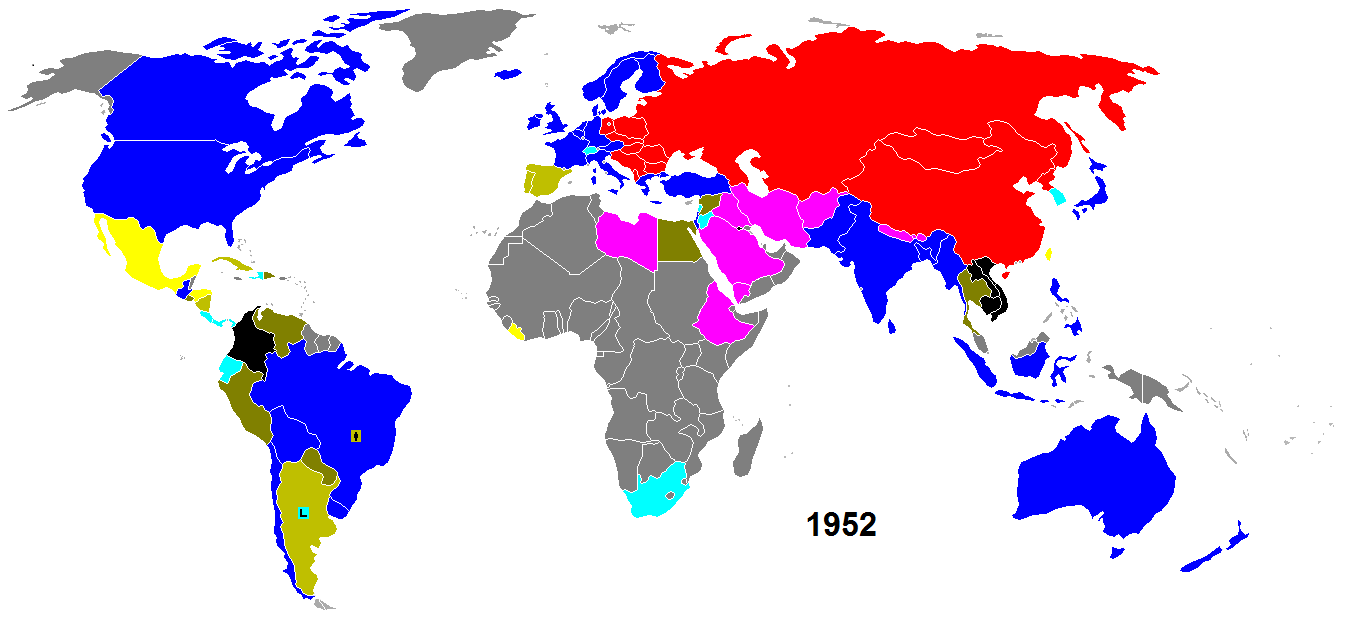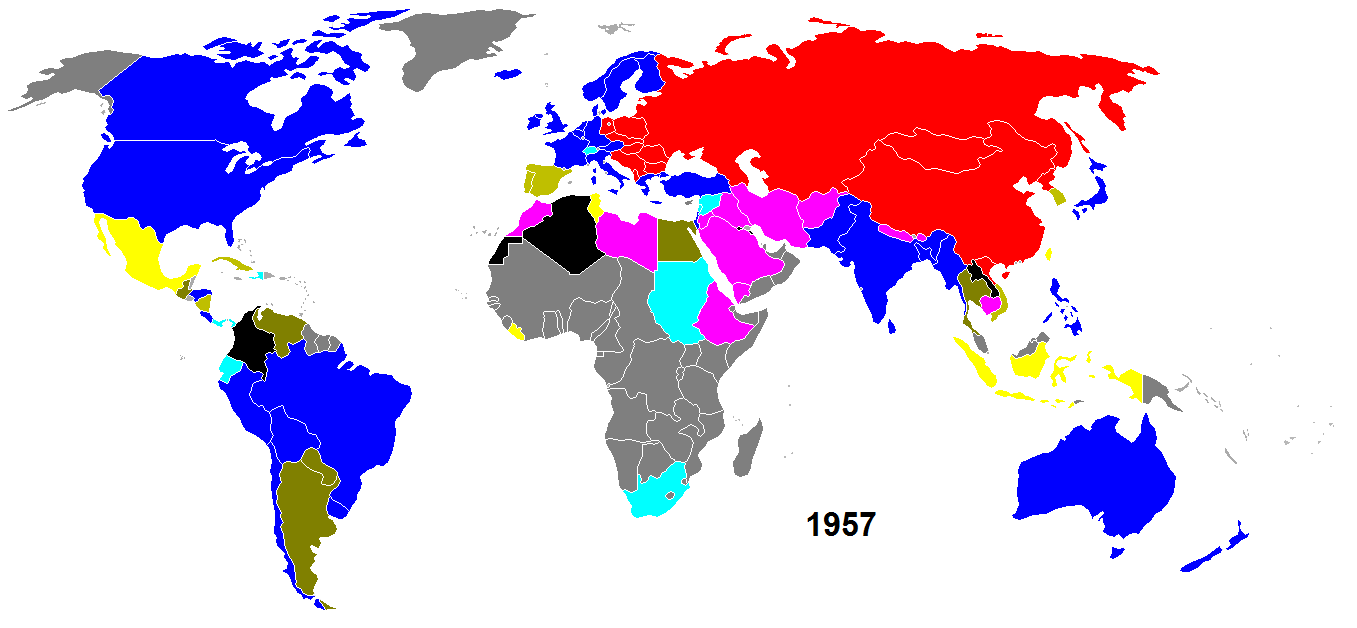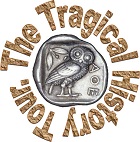
Chapter Twenty-six
The 1950s
- Major Gains: Colombia, Uruguay, Venezuela
- Major Losses: Indonesia
- Major Hiccups: Burma, Pakistan, Sudan, Syria
- Overall Trend: Upward, from 28% (1949) to 33% (1959)
With the fall of Fascism, the rise of Communism and the independence of several major colonies, over half of humanity had made a decisive break with the past. The 1950s were an era in which people tried to assess and react to the changes unleashed by the 1940s.
Two trends dominated. Communism, which had once been confined to only the Soviet Union and Mongolia, had now spread to 13 nations and a third of humanity. Democracy, which had been reduced to a mere 13 nations in endangered enclaves during the darkest days of the War, had now expanded to include almost half the world's population, the highest percentage in history thus far.
This clear rift between two ascendant and competing philosophies dominated geopolitics in the 50s. It showed itself in the military alliances of the times, and in the temporary borders that divided disputed territories like Germany, Korea, Vietnam and China.
With the world splitting into two power blocks – East and West – French demographer, anthropologist and historian Alfred Sauvy coined the term Third World in 1952 to refer to the nations that aligned themselves with neither side. Because so many former colonies in Africa, Latin America and South Asia were trying to stay out of the global chess game of the nuclear superpowers, the term soon became shorthand for poor countries everywhere, regardless of geopolitical orientation.
The collapse of imperialism stalled in the 1950s. There was still uncertainty about the eventual fate of Africa -- most Europeans considered the Africans too primitive to stand on their own -- and the French were overcompensating for their easy defeat in the World War by a stubborn refusal to surrender to nationalist movements, first in Indochina, then in Algeria. Although the British had abandoned India without a fight, they now bogged down fighting small wars and insurrections in Kenya, Malaya and Suez. Relatively few new nations arose in the 1950s.
Unified Europe
The problem remained: what to do about the Germans, the world’s most dangerous people. Sure, they seemed peaceful now, but if history was any guide, they might snap and attack at any moment. They had invaded France three times in three generations and needed to be leashed. Many French hoped to turn back time and return Germany to a patchwork of small agrarian statelets or, even better, an uninhabited wilderness. When that proved a no-go, they tried to detach the German industrial region of the Ruhr and place it under foreign occupation so Germany couldn’t use it to rebuild its war machine. Germany’s eastern coalfields in Silesia had been taken over by Poland, and now France wanted Germany’s western coalfields in the Saar and Ruhr. Unfortunately, this looked too much like the policies set up after WW1 that hadn’t worked then and probably wouldn’t work now. Eventually, France elected a more moderate government that tried to find a less punitive solution.
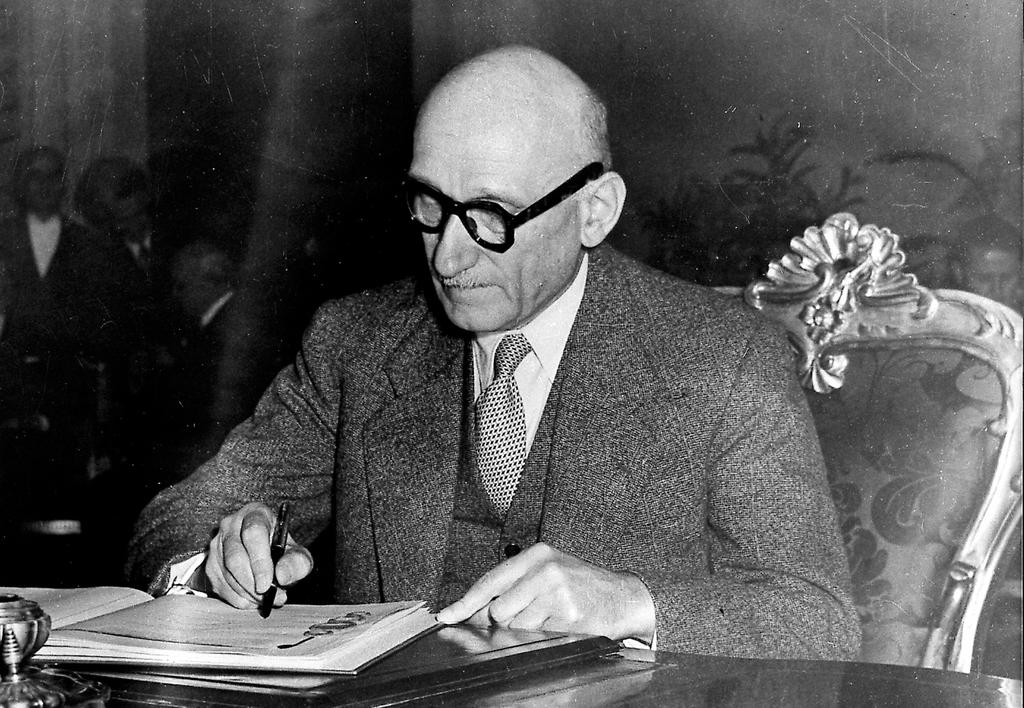 French
foreign minister Robert Schuman was originally from
Luxembourg, that little country wedged between France
and Germany. Because this had once been part of the old
German Confederation, he inherited German citizenship as
well, which allowed him to easily attend colleges in
Germany. After acquiring a law degree, he moved to
Alsace-Lorraine which at that time was a sliver of
Germany with a lot of French inhabitants, but after
World War One it became a sliver of France with a lot of
German inhabitants. This gave him French citizenship
instead. In any case, being from a part of the world
that got overrun coming and going during every war,
Schuman developed a keen interest in arranging a
permanent peace. And having one foot in each culture
meant he was inclined to find a solution that benefitted
both sides.
French
foreign minister Robert Schuman was originally from
Luxembourg, that little country wedged between France
and Germany. Because this had once been part of the old
German Confederation, he inherited German citizenship as
well, which allowed him to easily attend colleges in
Germany. After acquiring a law degree, he moved to
Alsace-Lorraine which at that time was a sliver of
Germany with a lot of French inhabitants, but after
World War One it became a sliver of France with a lot of
German inhabitants. This gave him French citizenship
instead. In any case, being from a part of the world
that got overrun coming and going during every war,
Schuman developed a keen interest in arranging a
permanent peace. And having one foot in each culture
meant he was inclined to find a solution that benefitted
both sides.
![flag of the European Coal and Steel Community [flag of the European Coal and Steel Community]](images/1958-Flag_of_the_European_Coal_and_Steel_Community.png) In
1950 Schuman proposed a common market for coal and steel
in Western Europe which would intertwine the national
economies and "make war not only unthinkable but
materially impossible." Schuman patiently negotiated the
Treaty of Paris in 1951, signed by France, West Germany,
Italy, Belgium, the Netherlands and Luxembourg, which
established the European
Coal and Steel Community, a common market for
industrial commodities. The first president of the
organization was Jean Monnet, a French statesman who had
been working many years to consolidate the nations of
West Europe.
In
1950 Schuman proposed a common market for coal and steel
in Western Europe which would intertwine the national
economies and "make war not only unthinkable but
materially impossible." Schuman patiently negotiated the
Treaty of Paris in 1951, signed by France, West Germany,
Italy, Belgium, the Netherlands and Luxembourg, which
established the European
Coal and Steel Community, a common market for
industrial commodities. The first president of the
organization was Jean Monnet, a French statesman who had
been working many years to consolidate the nations of
West Europe.
Monnet took his role as an international citizen of the world seriously. He fell in love with a married Italian woman, but the only country willing to give her a divorce in that prudish era was the Soviet Union. Since Russia was closed to travel from the West, Monnet had to travel there via the Soviet consulate in Shanghai.
France
![[French flag]](images/1794-Flag_of_France.png) The liberation
and restoration of democracy in France after World War
Two led to a decade of quarrelsome coalition governments
called the Fourth Republic. At the epicenter of
instability, the colonial war in Algeria was going badly
and draining France of money, manpower and will. It had
become a nasty, unwinnable war against a ruthless enemy
using brutal hit-and-run tactics. No one in Paris had
the slightest idea how to win this fight, and the
constant failure to solve the problem meant that
parliament couldn’t keep a cabinet for any length of
time. France tottered on the brink of chaos.
The liberation
and restoration of democracy in France after World War
Two led to a decade of quarrelsome coalition governments
called the Fourth Republic. At the epicenter of
instability, the colonial war in Algeria was going badly
and draining France of money, manpower and will. It had
become a nasty, unwinnable war against a ruthless enemy
using brutal hit-and-run tactics. No one in Paris had
the slightest idea how to win this fight, and the
constant failure to solve the problem meant that
parliament couldn’t keep a cabinet for any length of
time. France tottered on the brink of chaos.
Hardliners in the army were convinced that they weren’t getting enough support from Paris. In fact, rumors swirled that government might just admit defeat and pull out, so the army seized control from the colonial civilian government in Algiers on May 13, 1958. Paratroopers from the rebellious French army in Algeria then flew over and occupied Corsica. As the conspirators were getting ready to move on Paris, the government had no other choice but to call General Charles De Gaulle from retirement on May 29, 1958. As the only person with enough respect to stabilize the country, he was given a six-month license to rule by decree like an old-fashion Roman dictator.
![French president Charles de Gaulle (centre) in Brazzaville, French Equatorial Africa in 1958. [Charles de Gaulle]](images/1958_De-Gaulle.jpg) During
the crisis, a new constitution was written which would
become the basis for the Fifth Republic. This
constitution removed executive power from parliament and
placed it in the hands of a strong, independent
president, originally chosen by an Electoral College of
lesser office-holders, but soon amended to a direct
two-round election. The president was given the power to
appoint and dismiss the prime minister and dissolve
parliament. If that wasn’t enough, the president could
also invoke broad emergency powers at his discretion.
During
the crisis, a new constitution was written which would
become the basis for the Fifth Republic. This
constitution removed executive power from parliament and
placed it in the hands of a strong, independent
president, originally chosen by an Electoral College of
lesser office-holders, but soon amended to a direct
two-round election. The president was given the power to
appoint and dismiss the prime minister and dissolve
parliament. If that wasn’t enough, the president could
also invoke broad emergency powers at his discretion.
After this De Gaulle settled in as an ordinary president of France for another eleven years until his death in 1969. As a larger than life demigod, De Gaulle, made all national decisions without help from lesser men. He refused to let his country slip complacently into second-class status. De Gaulle turned France into a nuclear power, pulled out of NATO, and blocked Britain from entry into the European Community where they might threaten French continental hegemony. Although he abided by the new constitution, Polity IV considers France to be less than democratic the whole time that De Gaulle was in charge. The French score falls to 5 points from 1958 to 1969, which is just below the level they commonly use for counting democracies.
US Civil Rights Movement
![[USA flag]](images/1912-us-flag-48-stars.gif) After defeating
the Nazis, the United States was forced to face the
hypocrisy of how it treated its own minorities. When Reconstruction
ended in 1877, the former slave states had passed
a number of laws to keep their black population
subordinate and controlled -- a situation called Jim
Crow after a stock character in racist minstrel shows.
State laws not only allowed businesses and institutions
to segregate bathrooms, hotels, restaurants, schools and
mass transit, they required it. A business couldn’t
treat all customers equally even if it wanted to. Poll
taxes, literacy tests and general red tape made it
nearly impossible for blacks to vote.
After defeating
the Nazis, the United States was forced to face the
hypocrisy of how it treated its own minorities. When Reconstruction
ended in 1877, the former slave states had passed
a number of laws to keep their black population
subordinate and controlled -- a situation called Jim
Crow after a stock character in racist minstrel shows.
State laws not only allowed businesses and institutions
to segregate bathrooms, hotels, restaurants, schools and
mass transit, they required it. A business couldn’t
treat all customers equally even if it wanted to. Poll
taxes, literacy tests and general red tape made it
nearly impossible for blacks to vote.
There’s a tendency nowadays to treat segregation as a national sin and to not single out specific states for criticism, but the mechanisms of Jim Crow (such as poll taxes, lynching, anti-miscegenation laws and segregated schools) were very specifically concentrated in the 15 former slave states and very specifically absent from most northern states. With the exception of Indiana – always a conservative outlier - every state that had prohibited slavery in 1860 had prohibited segregated schools by 1940; they had never enacted a poll tax and could look back at a mostly lynch-free history. All except California, Oregon and Indiana had legalized interracial marriage by 1887.
Voting rights were among the last issues to be addressed in the fight over civil rights. The first broad victories in racial equality were bureaucratic. The federal civil service (1941) and the armed forces (1948) were integrated by the executive orders of Presidents Roosevelt and Truman. The U.S. Supreme Court ordered the integration of public schools in 1954. When the south continued to ignore the court rulings, ordinary people directed mass protest campaigns toward integrating public services. That’s when the politicians finally sat up and took notice.
As in all Southern communities, riders on the city buses of Montgomery, Alabama, were separated by race - whites in the front rows, blacks in the back rows, with whites allowed to take seats from black riders and make entire rows of them stand if all the white seats were full. A few federal courts had already decided that this sort of policy was illegal①, but Southern communities were dragging their feet over changing it.
One day in March 1955, a young black woman refused to surrender her seat to a white passenger on a full bus. The driver insisted she get up. As she later explained, she felt the legacy of the anti-slavery activists Harriett Tubman and Sojourner Truth bearing down on her, holding her in place. She refused to budge, so the police came and dragged her away as she screamed about her constitutional rights.
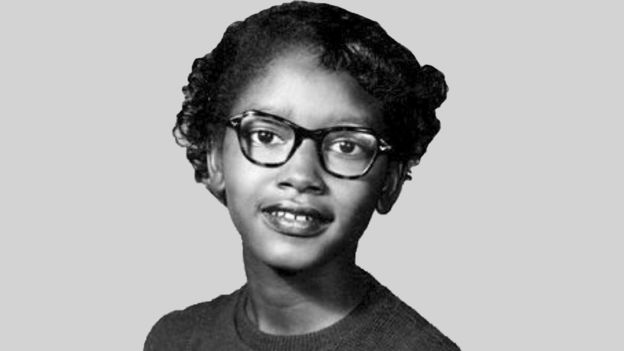 That
young lady’s name was Claudette Colvin. Unfortunately,
she was a smart, stubborn 15-year-old high school
student who came from a broken, makeshift family in the
worst part of town – probably not the right person
to convince timid white people that sitting next to
black people wasn’t so bad. Then she got pregnant out of
wedlock by an older married man. Her case worked its way
obscurely through the courts, but no one wanted to make
a big deal over it.
That
young lady’s name was Claudette Colvin. Unfortunately,
she was a smart, stubborn 15-year-old high school
student who came from a broken, makeshift family in the
worst part of town – probably not the right person
to convince timid white people that sitting next to
black people wasn’t so bad. Then she got pregnant out of
wedlock by an older married man. Her case worked its way
obscurely through the courts, but no one wanted to make
a big deal over it.
In December, two weeks before Claudette Colvin gave birth to her son, Rosa Parks was also arrested for not giving up her seat on another Montgomery bus. She was a polite, middle aged, middle class lady with a steady job and solid family, so southern black leaders rallied behind her and organized a boycott of Montgomery city buses.
![Martin Luther King, Jr. is arrested for "loitering" in Montgomery, Alabama, in September 1958. [MLK]](images/1958_martin_luther_king_jr_montgomery_arrest_1958.jpg) Among
them was Martin Luther King, a poetically eloquent
minister from Atlanta. He had no track record in
activism at the time, but the events in Montgomery would
launch King into national prominence. King would bring
Gandhi’s tactics of massive non-cooperation to the
American South. It required a year of carpools, biking
and walking to work to dry up the bus company’s revenue
stream and convince them to treat blacks and whites
equally. Even more than that, the boycott made
African-Amrican dissatisfaction visible as the entire
black community walked to work every morning. Meanwhile,
leaders of the boycott were attacked and jailed, but
they refused to retaliate with violence, which earned
them nationwide sympathy.
Among
them was Martin Luther King, a poetically eloquent
minister from Atlanta. He had no track record in
activism at the time, but the events in Montgomery would
launch King into national prominence. King would bring
Gandhi’s tactics of massive non-cooperation to the
American South. It required a year of carpools, biking
and walking to work to dry up the bus company’s revenue
stream and convince them to treat blacks and whites
equally. Even more than that, the boycott made
African-Amrican dissatisfaction visible as the entire
black community walked to work every morning. Meanwhile,
leaders of the boycott were attacked and jailed, but
they refused to retaliate with violence, which earned
them nationwide sympathy.
Now that African-Americans had figured out an effective protest strategy, they began to put it into operation all over the South.
Elsewhere
All over the world, countries with long autocratic histories were trying to get the hang of democratic governing.
The dictator Marcos Pérez Jiménez of Venezuela had promised to actually run for reelection instead of just announcing that he had already won, but in 1957, he changed his mind. Under his new plan, instead of facing a human opponent, he let the populace vote him up or down. When he won by a ridiculous margin, the people rioted in the streets. They chased him out of the country and held new, honest elections. He hid in the United States until he was extradited back to Venezuela on embezzlement charges and jailed.
Turkey had been under the rule of Ataturk since the last Greco-Turkish War. In that era of larger-than-life dictators, Ataturk is probably the only one who came close to the elusive ideal of a benevolent dictator. At least the Turks think so, and don’t try to tell them otherwise. In just 20 years, he transformed the seventeenth century backwater that was the Ottoman Empire into the modern twentieth century Turkey.
President İsmet İnönü inherited Turkey after Ataturk died in 1938, and he tried to deflect growing international pressure by allowing Turkey’s first multiparty elections in 1946, but the votes were cast publicly and counted secretly, so the ruling Republican People's Party could 1) punish anyone who voted the wrong way, and 2) pretty much make up the results anyway. Unable to defend that practice, Turkey broke down and had its first really free elections (where the votes were cast secretly and counted publicly) in May 1950. Adnan Menderes of the moderate right-wing Democratic Party became prime minister, and later won two more free elections, one in 1954 and the other in 1957.
Colombia
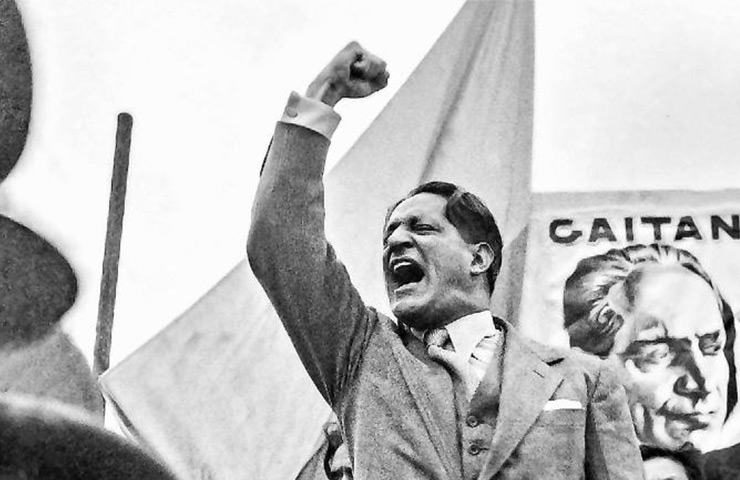 Jorge Gaitán of
the Liberal Party, a popular democratic reformer with a
pleasant face and a charismatic style, was shifting the
focus of his party from the elite to the dispossessed.
In April 1948, Gaitán
was on the verge of being elected president of
Columbia when he was shot down in mid-speech during a
campaign rally. The crowd immediately swarmed and killed
the assassin and then rampaged angrily through downtown
Bogota for several days. By the time the massive riot
was brought under control 2,000 people were dead and the
city was devastated.
Jorge Gaitán of
the Liberal Party, a popular democratic reformer with a
pleasant face and a charismatic style, was shifting the
focus of his party from the elite to the dispossessed.
In April 1948, Gaitán
was on the verge of being elected president of
Columbia when he was shot down in mid-speech during a
campaign rally. The crowd immediately swarmed and killed
the assassin and then rampaged angrily through downtown
Bogota for several days. By the time the massive riot
was brought under control 2,000 people were dead and the
city was devastated.
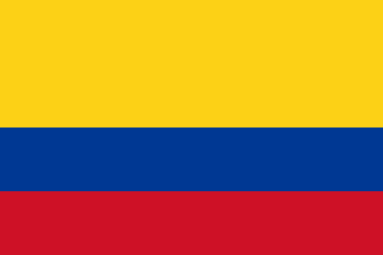 At
the time, the two parties of Colombia ran the government
jointly, but in the wake of the violence, Conservative
president Mariano Ospina clamped down and threw all the
Liberals out of his coalition cabinet. Congress began to
talk about impeachment for overstepping his authority,
so Ospina just closed Congress altogether. For the next
ten years, the right wing refused to share any
government posts and the left wing boycotted all
elections in protest. By then, the violence had spread
to the countryside. Conservative paramilitaries fought
the paramilitaries of the Liberal and Communist parties
in a 10-year civil war known simply as The Violence (La
Violenzia) which killed 200,000 Colombians.
At
the time, the two parties of Colombia ran the government
jointly, but in the wake of the violence, Conservative
president Mariano Ospina clamped down and threw all the
Liberals out of his coalition cabinet. Congress began to
talk about impeachment for overstepping his authority,
so Ospina just closed Congress altogether. For the next
ten years, the right wing refused to share any
government posts and the left wing boycotted all
elections in protest. By then, the violence had spread
to the countryside. Conservative paramilitaries fought
the paramilitaries of the Liberal and Communist parties
in a 10-year civil war known simply as The Violence (La
Violenzia) which killed 200,000 Colombians.
La Violenzia ended in 1958 when the Liberals and
Conservatives agreed to split the cabinet posts among
themselves and alternate in the presidency. Known as the
National Front, this brought most power blocs into the
government and satisfied everyone who really mattered.
Unfortunately it also shut out everyone who didn’t
matter, many of whom now joined the Communists. They
took a short breather and started up another civil war
in 1964, but since the Communists were a minority of a
minority stuck way out in the boondocks, the trouble
they caused was smaller than La Violenzia, and Columbia
learned to live with it. The National Front lasted until
1974, when competitive elections started again.
Premature Democratization
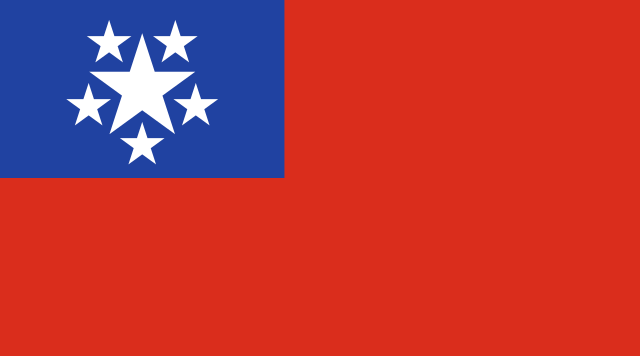 In
1948 Burma became an independent parliamentary republic
under Prime Minister U Nu of the Anti-Fascist
People's Freedom League, which was a broad coalition
formed around a backbone of
In
1948 Burma became an independent parliamentary republic
under Prime Minister U Nu of the Anti-Fascist
People's Freedom League, which was a broad coalition
formed around a backbone of 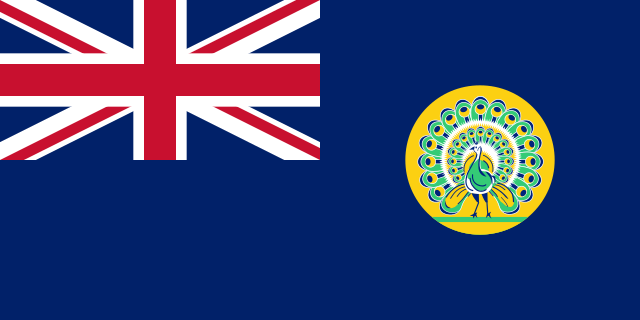 pre-war
anti-British dissidents who then turned into
anti-Japanese partisan guerrillas during World War Two.
For the next few years U Nu remained securely in charge
until his party won the 1956 election by a smaller
margin than he wanted. He took a brief hiatus to
whip them back into shape, and then U Nu
returned as prime minister in 1957.
pre-war
anti-British dissidents who then turned into
anti-Japanese partisan guerrillas during World War Two.
For the next few years U Nu remained securely in charge
until his party won the 1956 election by a smaller
margin than he wanted. He took a brief hiatus to
whip them back into shape, and then U Nu
returned as prime minister in 1957.
![1948: U Nu [1948-U-Nu-Burma]](images/1948-U-Nu-Burma.jpg) Most
of Burma’s leaders detested each other on a visceral,
personal level, and their feuds drove wedges into
politics. In 1958 the AFPFL split into U Nu’s
“Clean” faction and the opposing
“Stable” faction, each of whom accused the other of
communism, atheism and corruption. Without a majority, U
Nu was forced to hand power to a military caretaker
government under General Ne Win (also widely hated)
until it could be straightened out. In April 1960, a
landslide victory in new elections returned U Nu to
power.②
Most
of Burma’s leaders detested each other on a visceral,
personal level, and their feuds drove wedges into
politics. In 1958 the AFPFL split into U Nu’s
“Clean” faction and the opposing
“Stable” faction, each of whom accused the other of
communism, atheism and corruption. Without a majority, U
Nu was forced to hand power to a military caretaker
government under General Ne Win (also widely hated)
until it could be straightened out. In April 1960, a
landslide victory in new elections returned U Nu to
power.②
Like most nations assembled during the colonial era, Burma was an uncomfortable multiethnic mix of traditional enemies whose only commonality was that they had all been conquered by the same Europeans. All throughout Burma's subsequent years of independence, several low-grade ethnic civil wars have smoldered in the boondocks. On top of those, a renegade remainder of the defeated Nationalist Chinese dug into the borderlands of Burma and China to continue the fight against Communist China. A Communist rebellion in neighboring Laos also spilled over the border into Burma. Thinking he could squash these better than the civilian government, General Ne Win ousted U Nu in April 1962 and established a tight military dictatorship that outlived the general and has remained one of the world’s most oppressive regimes until very recently.
After being ousted, U Nu spent four years in jail until 1966. Three years later in 1969 he was allowed to leave Burma to visit Buddhist shrines overseas, but instead he went to London to organize dissidents in exile.Ⓐ
Similar things were happening all across the globe. Many post-colonial democracies started with bright dreams that fizzled out after a decade or so of reality. Sukarno, Indonesia’s founding rebel and democratically elected president since 1945, declared martial law in March 1957 and ended Indonesia's liberal parliamentary system; a couple of years later, in 1959, Sukarno returned to the 1945 Constitution with its strong presidency, but he only allowed the parliament to function under what he called "Guided Democracy" where most seats were filled by his own appointees. Parliamentary democracy was overthrown in Sudan in 1958 by a military coup, after which General Abbud banned opposition parties. Heading briefly in the other direction, a February 1954 coup in Syria ousted their dictator and allowed their first president Shukri al-Quwatli to return as leader of a democratic republic, but that only lasted until 1958.
In 1956 Pakistan enacted a new constitution declaring the country a democratic republic rather than a dominion of the British crown. Major General Iskander Mirza, who was already representing Queen Elizabeth as governor-general, stuck around as president. Elections came and went, but after a string of hapless prime ministers failed to stabilize the government, President Mirza declared martial law on October 7, 1958. He dissolved the National Assembly and all the little provincial legislatures. He banned political parties. On October 27, Mirza appointed General Ayub Khan, the Commander-in-Chief of the Pakistani Army, to be the new prime minister, but Ayub turned right around and deposed Mirza. Ayub abandoned Pakistan’s democratic constitution, permanently dissolved its political parties and left the day-to-day operations of government in the hands of soldiers and bureaucrats while he pulled the strings.
However, in a handful of colonies, democracy survived long enough to stabilize. In 1957, the British bundled all their colonies around the Malay Straight into one federation and turned them loose as Malaysia. Jamaica got self-rule in 1959 and independence in 1962; since then it’s had nothing but boring democracy.
Monarchy Rejuvenated
Upon independence, many colonies reverted to the original government they had before the Europeans had taken over. Former monarchies were returned to the hands of previous dynasties. In keeping with the optimistic liberalism of the age, however, most of the departing colonial masters tried to get the restored monarchs to abide by constitutions, with mixed results.
![old flag of Laos [Laos flag]](images/1952-Flag_of_Laos_%281952-1975%29.png) King
Sisavang Vong of Laos had reigned under both French and
Japanese occupation since 1904, but he got a brief taste
of independence between the Japanese surrender in August
1945 and the resumption of French control in April 1946.
The French allowed free elections in December 1946 and
finally set the country free in February 1950.
Unfortunately, the Kingdom of Laos was almost
continuously in the grips of a civil war with the
Communists throughout its existence, so it never really
had the stability necessary to flourish as a democracy.
They tried their best, however, and maintained a
vigorous electoral process with multiple parties in
peaceful districts, but the only time they achieved real
democracy was 1958-59 when they reached a temporary
accommodation with the Communists.
King
Sisavang Vong of Laos had reigned under both French and
Japanese occupation since 1904, but he got a brief taste
of independence between the Japanese surrender in August
1945 and the resumption of French control in April 1946.
The French allowed free elections in December 1946 and
finally set the country free in February 1950.
Unfortunately, the Kingdom of Laos was almost
continuously in the grips of a civil war with the
Communists throughout its existence, so it never really
had the stability necessary to flourish as a democracy.
They tried their best, however, and maintained a
vigorous electoral process with multiple parties in
peaceful districts, but the only time they achieved real
democracy was 1958-59 when they reached a temporary
accommodation with the Communists.
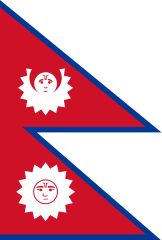 The
Kingdom of Nepal in the Himalayan Mountains had not only
a hereditary monarchy, but a hereditary prime ministry
as well. For over 100 years, all prime ministers had
come from the Rana family. With the independence of
India, however, the ruling class of Nepal lost the
British protection that had held back the forces of
change. By 1950, dissatisfaction with the Rana family
had boiled over, and they had to flee to safety in
India. The king was allowed to remain, but only after he
agreed to share power with parliament, which was not
democratic but represented the important families in
Nepal. A few years later in 1959, a weak and
inexperienced new king, Mahendra, bowed to internal
pressure and reluctantly granted a fully democratic
constitution. He held elections, but a year and a half
later, he was fed up with sharing power. He had finally
found his footing and was secure enough in power to
disband parliament and arrest the socialist prime
minister, Bishweshwar Prasad Koirala, and his closest
associates.
The
Kingdom of Nepal in the Himalayan Mountains had not only
a hereditary monarchy, but a hereditary prime ministry
as well. For over 100 years, all prime ministers had
come from the Rana family. With the independence of
India, however, the ruling class of Nepal lost the
British protection that had held back the forces of
change. By 1950, dissatisfaction with the Rana family
had boiled over, and they had to flee to safety in
India. The king was allowed to remain, but only after he
agreed to share power with parliament, which was not
democratic but represented the important families in
Nepal. A few years later in 1959, a weak and
inexperienced new king, Mahendra, bowed to internal
pressure and reluctantly granted a fully democratic
constitution. He held elections, but a year and a half
later, he was fed up with sharing power. He had finally
found his footing and was secure enough in power to
disband parliament and arrest the socialist prime
minister, Bishweshwar Prasad Koirala, and his closest
associates.
Iran
![[Iran]](images/1906-Flag_of_Iran_with_standardized_lion_and_sun.svg.png) The
era saw democracy famously miscarry in Iran. The British
and Soviets had occupied Iran (Persia) during the Second
World War to establish a safe corridor for getting
supplies to Russia. Because the ruling monarch, the Reza
Shah (formerly the army officer Reza Khan), seemed too
fascist and sympathetic to Hitler, they pressured him
into abdicating in favor of his son, Mohammed Reza Shah.
At the same time, they encouraged the new shah to rule
in accordance with the almost forgotten liberal
constitution of 1906. There was a flowering of
political activity in Iran, which was rudely cut short
as soon as the Iranians tried to keep more of their
nation’s oil wealth for themselves instead of letting
the British take it all.
The
era saw democracy famously miscarry in Iran. The British
and Soviets had occupied Iran (Persia) during the Second
World War to establish a safe corridor for getting
supplies to Russia. Because the ruling monarch, the Reza
Shah (formerly the army officer Reza Khan), seemed too
fascist and sympathetic to Hitler, they pressured him
into abdicating in favor of his son, Mohammed Reza Shah.
At the same time, they encouraged the new shah to rule
in accordance with the almost forgotten liberal
constitution of 1906. There was a flowering of
political activity in Iran, which was rudely cut short
as soon as the Iranians tried to keep more of their
nation’s oil wealth for themselves instead of letting
the British take it all.
During their previous occupations of Iran, the British had bullied and bribed their hosts into granting them lucrative terms for extracting oil from Iran, but now the Iranians wanted their national wealth back. Iranian Prime Minister Haj Ali Razmara had almost negotiated a better profit-sharing deal with the Anglo-Persian Oil Company in March 1951 when radical nationalists gunned him down for offering the British too many concessions. He was the last strong opponent of just nationalizing all oil production outright, so with him gone, Parliament voted almost unanimously to seize the oil industry for the Iranian nation. They then selected the chief architect of that law, the European-educated, slightly socialist and dangerously independent Mohammad Mosaddeq, to be the new prime minister.
The West was horrified. To discourage other countries from getting the idea that they could seize valuable industries away from foreign corporations with impunity, the West immediately organized an international boycott of Iranian oil, while MI6 and the CIA poured money into Iran to support Mosaddeq’s enemies and feed a propaganda machine to undermine and discredit his reputation. They hoped to convince the Iranian people that the shah needed to fire Mosaddeq and let the British take away all that dirty, nasty oil.
![Queen Soraya, the Shah, Prime Minister Mossadegh and members of the Government [The Shah & PM Mossadegh]](images/1951-ShahSorayaPM.jpg) The
problem was that Mohammed Reza Shah didn’t want to take
on the extremely popular Mosaddeq just yet. Yes, the
shah wanted to regain economic access to the West, but
Mosaddeq’s two and a half years in charge was the first
stable government Iran had seen in many years. Other
cabinets had lasted an average of six months in the
years since Reza Shah. Mosaddeq’s Popular Movement was a
centrist coalition of moderates that kept both the
communists of the far left and the religious zealots of
the far right at bay.
The
problem was that Mohammed Reza Shah didn’t want to take
on the extremely popular Mosaddeq just yet. Yes, the
shah wanted to regain economic access to the West, but
Mosaddeq’s two and a half years in charge was the first
stable government Iran had seen in many years. Other
cabinets had lasted an average of six months in the
years since Reza Shah. Mosaddeq’s Popular Movement was a
centrist coalition of moderates that kept both the
communists of the far left and the religious zealots of
the far right at bay.
After the conservatives Churchill and Eisenhower replaced liberals Attlee and Truman at the helm of the Western powers, the British and Americans decided sanctions and propaganda were not enough and it was time to fix their Iranian problem once and for all. Afraid of Iran suddenly lurching toward Moscow, Western intelligence had already lined up friendly officers in the Iranian army willing to arrest Mosaddeq and his allies as soon as they got permission.
Worried that Parliament could be bribed into voting him out, Mosaddeq unilaterally dissolved Parliament in July 1953, and began ruling by decree until new elections could be held; however, sending everyone home like this made many of Mosaddeq’s lukewarm supporters suspect he was planning to take dictatorial power, so they started drifting away from his side.
The shah still hesitated. The CIA flew his iron-willed sister from the south of France to talk him into it. In August 1953 the CIA tried to make it painfully simple for the shah by drafting a decree dismissing Mosaddeq and putting the compliant General Zahedi in charge of the army. All he had to do was sign it.
Mosaddeq got wind of this, and his supporters poured into the streets to back him up; the shah panicked and fled to Iraq while General Zahedi went into hiding. After about a week, the CIA conceded defeat and cabled its agents to stand down and come home. The next day, however, protesters in favor of the shah (including royalists, religious conservatives and street thugs hired by the CIA) got the upper hand in the streets and drove Mosaddeq from power. Mohammed Reza Shah came home, ruthlessly consolidated power and never let democracy get out of hand again. Mosaddeq remained under house arrest for the rest of his life.Ⓑ
The coup against Mosaddeq has acquired mythic status as America’s original sin in the Middle East, in which the CIA overthrew a democratically elected government in order to secure all that sweet, precious oil, but it’s probably worth noting that the US at that time produced most of its own oil domestically and didn’t really need any more, so it was more interested in stopping Communism than stealing oil. Remember that joint British-Soviet occupation during World War Two? Well, in 1946, right after the war, the Soviets tried to hang on to their occupation zone and develop it into a couple of satellite nations just as they did in North Korea and East Germany. Iran complained to the fledgling United Nations, which at the time was still bustling with youthful energy and able to force Stalin to pull out. That memory was still fresh in 1953 when Mosaddeq started seizing foreign property.
The legendary 1953 coup in Iran was not so much a coup and more just a monarch firing his prime minister, which happens all the time, and Iran was not even close to democratic anyway. For example, religious leaders had veto power over new legislation. Plus, there were always plenty of sneaky shenanigans behind the scenes. For example, during the 1952 parliamentary elections, Prime Minister Mosaddeq stopped counting ballots once a quorum was reached -- in essence, counting the quickly reported urban votes for his party while dismissing the slowly arriving rural votes for his religious fundamentalist opponents. In the 1953 crisis, Mosaddeq was ruling by decree without parliamentary approval. Obviously, the West got its hands dirty by backing a thug who would only get worse as the years progressed, but it’s not quite as black-and-white as some people would have you believe. Like most history, it’s more dark gray and light gray.
-- Matthew White

![[Previous Chapter]](images/previous_arrow.gif) |
![[Next Chapter]](images/next_arrow.gif) |
① Sarah Mae Flemming v. South Carolina Electric and Gas Company, 224 F.2d 752 (4th Cir. 1955)
② One of the odder eccentricities of the regime is that Ne Win’s lucky number was nine, so he organized all currency into units of nine, impoverishing anyone who had stockpiled traditional base-ten banknotes.
Ⓐ Richard Butwell, U Nu of Burma (Stanford University Press, 1969)
Ⓑ Mark J. Gasiorowski, Malcolm Byrne (ed.). Mohammad Mosaddeq and the 1953 Coup in Iran (Syracuse University Press, 2004). New York Times, “Secret History of the CIA in Iran” (2000) http://partners.nytimes.com/library/world/mideast/041600iran-cia-index.html
Copyright © May 2019 by Matthew White
